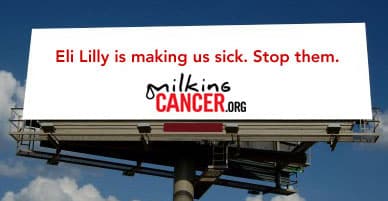by Eleanor J. Bader
Three years ago, The International Journal of Chemistry published an article positing Biphenyl-A, or BPA, as a primary culprit in the breast cancer epidemic of the past 50 years. The report sounded an alarm because BPA has not only been used to make plastic and epoxy resins, but has become embedded in American life, found in everything from food packaging to children’s sippy cups to flame retardants. Most frightening, more than eight billion pounds of the 54-year-old product enters the marketplace each year.

While The Journal study caused a flurry of attention among policy makers, the findings did not come as a surprise to Breast Cancer Action, a San Francisco based activist organization that works to publicize — and organizes to stop – the environmental causes of breast cancer. Elenore Pred, Breast Cancer Action’s founder, had an ambitious goal when she started the group in 1990: She wanted people to recognize breast cancer as a public health emergency rather than as a personal crisis.
It’s not that Breast Cancer Action minimizes the upheaval caused by a breast cancer diagnosis. Far from it. Instead, the group delves into the whys, looking into every possible cause for breast cancer’s ubiquity, from proven causal links like family history, tobacco usage, obesity, and a sedentary lifestyle, to less publicized — and in some circles less agreed upon — illness triggers, including chemicals found in the foods we eat and products we use.
At its core, says Communications Manager Angela Wall, Breast Cancer Action advocates “precautionary principles.” That is, if there is evidence that something is bad for human health, Breast Cancer Action believes, quite simply, that it should not be used. “Once we know something is hurting us, how much evidence do we need before we stop putting it into our bodies?” she asks.
“Milking Cancer” Causes A Stir
Take the Recombinant Bovine Growth Hormone, r-BGH, a genetically engineered chemical compound, also known as Posilac, that was developed by Monsanto and approved by the FDA in 1993. While r-BGH increases milk production by approximately 10 percent, it also causes cows to develop health problems including mastitis and bacterial infections. Worse, milk from r-BGH-treated cows contains hormones that medical experts such as Dr. Samuel S. Epstein, Chair of the Cancer Prevention Coalition and author of Got [genetically engineered] Milk?, believe increase the risk not only of breast cancer, but of colon, lung, and prostate cancers.
Breast Cancer Action responded to the researchers’ findings by creating the Milking Cancer campaign in 2009. Unlike organizations that try to stop individual dairies from using r-BGH, BCA has gone to the source, targeting pharmaceutical giant Eli Lilly, the sole worldwide manufacturer of r-BGH. “We feel that the way to stop cancer is to stop making things that cause it,” Wall says. “The hypocrisy here is obvious. Eli Lilly — which purchased Monsanto’s Posilac Division in 2008 for $300 million–sells drugs to treat cancer while also producing a product that is a known carcinogen. We’ve already collected more than 6,000 signatures on a petition asking Lilly to stop making r-BGH and there’s been a groundswell of support at the grassroots level to end its production. But we know that winning this fight is going to require a long, hard organizing effort.”The tip of a chemical iceberg
| The tip of a chemical iceberg |
That said, some headway is already evident. A campaign called Yoplait: Put a Lid On It prompted General Mills to stop using milk from cows treated with r-BGH in its yogurt. Shortly after Yoplait agreed to this, Dannon followed suit. Other companies, including Wal-Mart, Starbuck’s and Ben and Jerry’s have also committed to selling or using r-BGH-free products.
Pesticides are also prominent on Breast Cancer Action’s agenda. They are currently focusing on methyl iodide and have teamed up with the Pesticide Action Network of North America to prohibit its use in California’s strawberry and tomato fields.
Dr. John Froines, chair of the California Scientific Review Committee, called methyl iodide “one of the most toxic chemicals on earth.” That statement, along with similarly condemnatory testimony from other scientists, set Breast Cancer Action’s wheels in motion. They’ve put the precautionary principle into action, and are demanding that methyl iodide not be sprayed on the fruits and vegetables we eat. While some may think it’s a no-brainer to avoid a known poison, the Environmental Protection Agency (EPA) approved the use of methyl iodide in 2008. Their rationale? According to FDA officials, methyl iodide is toxic only if consumed or inhaled in enormous quantities. Not so, say PANNA, Breast Cancer Action, and other activists. They brought their concerns to newly installed California Governor Jerry Brown on his first day in office — January 1, 2011 — and anxiously await his response to their demand that he stop the chemical from being used on crops.
And methyl iodide is just the tip of the chemical iceberg, which is why Breast Cancer Action is actively involved in pushing Congress to revise the 35-year-old Toxic Substance Control Act, or TOSCA. As a member of the “Safer Chemicals, Healthy Families Coalition, they’re asking Washington to revisit the way chemicals are tested and approved. According to the Coalition, “TOSCA grandfathered in 62,000 chemicals when it was initially passed in 1976 without requiring further testing to demonstrate safety.” Even more frightening, only a few of the more than 82,000 substances currently in use have been tested and only a handful of the most venomous –lead, mercury, and polychlorinated biphenyls — have been outlawed or limited. “Traditionally, chemicals have been regulated one at a time,” Breast Cancer Action Program Manager Kimberly Irish says. “We want a sweeping change that puts the onus on companies to prove that something is safe before it is released to the public.”
Beauty products — from shampoos, to make-up, to nail polishes — are a prime example and women’s groups and environmental activists have begun to focus on the danger they pose to both workers and consumers. Breast Cancer Action is presently participating in the California Healthy Nail Salon Collaborative, a project that has brought manufacturers, salon owners and workers together. “The industry folks feel it’s up to workers and owners not to breathe in fumes; the workers and owners feel there should be better, safer products,” Irish explains. “Many salon workers have breathing problems and asthma. They also have an increased risk of breast cancer from what’s known as the toxic trio in polishes and sealants: Formaldehyde, toluene, and dibutyl phthalate.” A small victory was won when San Francisco passed an ordinance — the Collaborative hopes that it will become a national model — giving a “green business” citation to salons that do not use toxic products.
Collectively Questions to Get Action
These campaigns — centered on advocacy to eradicate the pollutants that cause breast cancer — form the crux of Breast Cancer Action’s day-to-day work. “Involuntary exposures” are the prime target, explained former Executive Director Barbara Brenner in a 2007 podcast. “(T)he things to which we are involuntarily exposed are things that people can’t protect themselves against just by changing their behavior. That’s a question of what we all need to work on together,” Brenner said.
Breast Cancer Action has also taken on drugs that are approved to treat breast cancer. Case in point, Avastin. The group was instrumental in pushing the Food and Drug Administration (FDA) to remove Avastin as a breast cancer treatment in December 2010. According to Irish, Breast Cancer Action looks at three things when assessing the efficacy of a particular drug. “It has to improve the patient’s survival rate, improve the person’s overall quality of life, and cost less than other similar treatments,” she begins. “In the case of Avastin, the drug was approved for breast cancer patients in 2008. Approval was fast-tracked, meaning it did not go through the full rigor of drug trials. When it was studied, researchers found that it did not prolong life, cost $88,000 a year, and caused perforation of the stomach lining and heart attacks in some users.”

And Breast Cancer Action is also mindful of the fact that race, economics, and where we live and work impact survival rates and treatment choices. Indeed, while one in eight U.S. women will develop breast cancer, African Americans and Latinas die earlier than their Caucasian peers. Finding out why, and then changing these conditions, is at the heart of Breast Cancer Action’s mission.
“We use a social justice lens in all of our work,” says Program Manager Kimberly Irish. “We ask, how can we eliminate social inequalities as they apply to breast cancer?
Part of the answer, say Breast Cancer Action staff, is making clear and accessible information available to everyone who needs it. This means that in addition to its community organizing efforts, Breast Cancer Action attends to the needs of people with breast cancer as well as their loved ones.
“We receive more than 1,000 calls a year from women who are newly diagnosed or who have a family member or friend who was just diagnosed,” Wall says. “Sometimes they don’t understand what’s happening and sometimes they want more information about a particular stage of cancer or a particular treatment. They ask lots of questions: ‘I’m 35. Should I have a mammogram?’ Or, ‘My mom died of breast cancer. Do you think I should be tested to see if I have the gene that predisposes me to the disease?’”
It goes without saying that Breast Cancer Action tries to provide callers with good, solid data and referrals. Still, the bulk of their organizing centers on fighting for a safer, cleaner world. This puts them at odds with those who favor pink ribbon “awareness” campaigns. After all, Breast Cancer Action asks, what good is awareness if the root causes of breast cancer remain unchanged?
Eleanor Bader is a freelance writer, teacher, and activist. She writes for The Brooklyn Rail, The L Magazine, RHRealitycheck.org, and other progressive and feminist publications.
Also see: Tribute to Barbara Seaman: Triggering a revolution in women’s health care in this edition of On The Issues Magazine.
Also see: Related Stories on Environmental Health from our Archives in this edition of On The Issues Magazine.
Visit The Café of On The Issues Magazine for new stories and updates.
